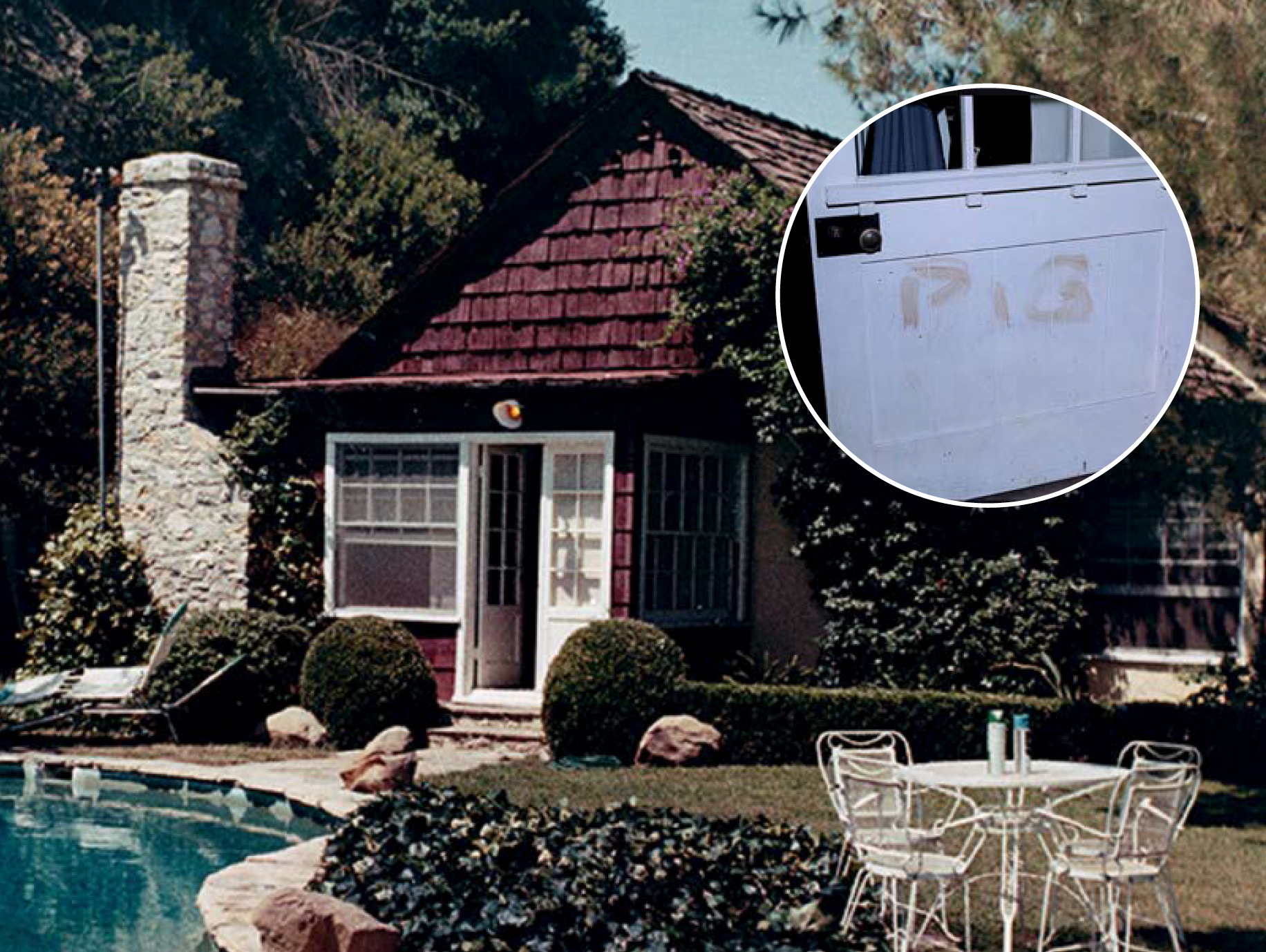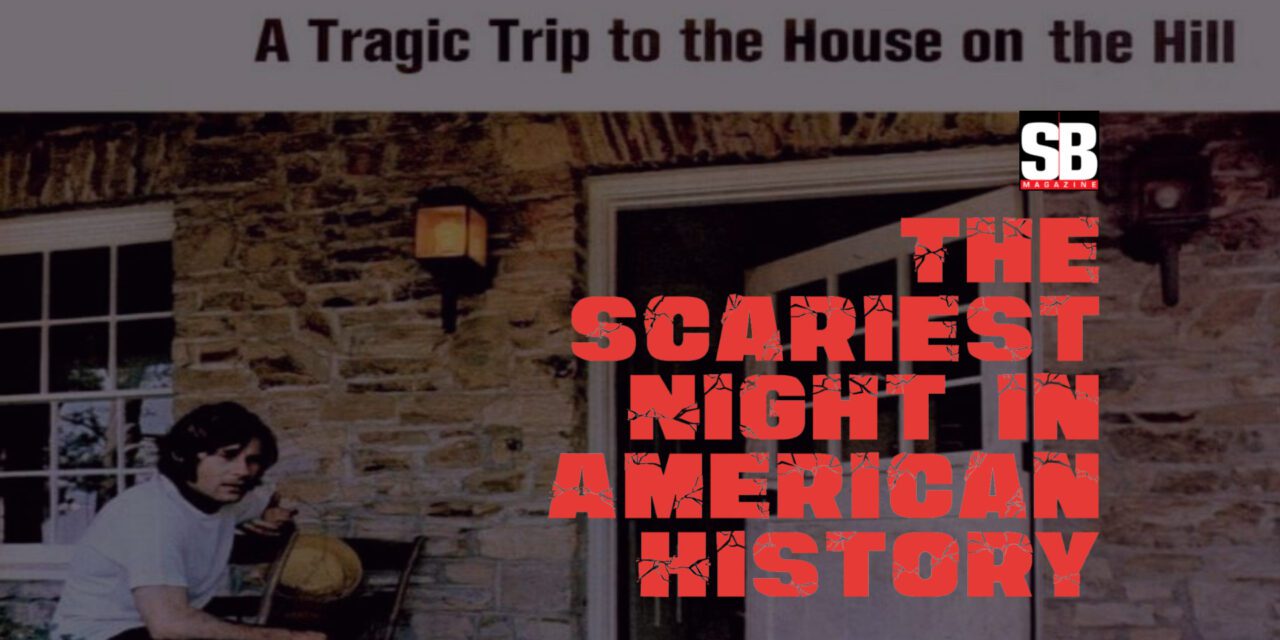In the early morning hours of August 9, 1969, four perpetually drug-addled members of Charles Manson’s “family” would amble over to the house at 10050 Cielo Drive in the Benedict Canyon region of Beverly Hills with absolutely no idea how much of an indelible mark they were about to make in the annals of American history. The four in question were Charles “Tex” Watson, Susan “Sadie” Atkins, Patricia “Katie” Krenwinkel, and Linda Kasabian, who had no family moniker since she had only been involved with the family two weeks but was sent on the mission because she had the only valid driver’s license in the clan. They were ordered by Manson to go to that house and “totally destroy everyone in that house, as gruesome as you can,” and to “leave something witchy.” In a trial that would later include defendants who shoved the prosecutor’s papers off a desk, wore acid-laced dresses to court, and lunged at the judge while he was talking, six innocent lives were lost that night, including an unborn baby. History has recorded the details of these crimes for the last 55 years; for this story, “something witchy” indeed was left: the blood of slain, pregnant, 26-year-old actress Sharon Tate was used to smear the word “PIG” on the front door of the house, Tate was an up-and-coming actress of the day who was not the “It” girl of Hollywood, but close to it (think Olivia Wilde or Blake Lively, not Jennifer Aniston or Julia Roberts). However, she was married to the “It” director of the day, Roman Polanski, the Quentin Tarantino of the late 60s. She was also the unofficial inspiration for the iconic “Malibu Barbie,” a character that recently had a successful run in theaters, after playing a character called “Malibu” in a 1967 film named “Don’t Make Waves.” Ironically, “Barbie” is played by Margot Robbie, who played Sharon Tate in “Once Upon a Time in Hollywood,” a 2019 film directed by Quentin Tarantino whose plot spun a fictionalized account around the night of the Tate murders After the murders at Cielo Drive, time seemed to stand still for the next 20 years. Previous residents had included Cary Grant and Dyan Cannon, Henry Fonda, Paul Revere and the Raiders, and other assorted figures of the day who came over to hang out. The owner of the house, Rudolph Altobelli, a manager of different stars of the day in Hollywood, had been leasing it to Tate and her husband at the time of the murders.
After the murders, Altobelli just moved in himself, locating a tenant being a new challenge, and something he would continue to be unsuccessful at for the next 20 years. Finally, in September 1988, Altobelli sold the home, and its ownership would change hands again in less than two years to investor Alvin Weintraub, who would try to sell the house himself a year later, to no avail. Defeated, Weintraub eventually tore the house down and had a new property built in its place after the last tenant left.
The house that stands in its place today has been nicknamed “Villa Bella” by Weintraub, before “Full House” creator Jeff Franklin bought it and renovated it into a modern 21,000-square-foot monstrosity. Weintraub also changed the address to 10066 Cielo Drive instead of 10050, in a further attempt at separating the property from its past.
Back to the last tenant who rented the property before it was torn down because this is where Shreveport gets involved. Reznor left the house in December 1993 but was not completely over the house’s macabre appeal; he took the front door that had Tate’s blood on it with him to use at his new recording studio, “Nothing Studios,” in New Orleans at 4500 Magazine Street (rumor has it he paid some of the construction workers razing the house some money to let him take the door). It stood as the entry door to the studio until he relocated back to L.A. in 2004. Strangely, he just left it at the New Orleans studio, where it sat untouched for the next eight years, and miraculously was not harmed by Hurricane Katrina. In 2012, a local plastic surgeon bought the property for his business, and upon discovering the significance of the front door, took it out of the dumpster. This is where the story hits home: Shreveport native Christopher Moore, who was living in New Orleans at the time, bought the door from the doctor, who had been keeping it in his mother-in-law’s house. Though he has since had the door auctioned off at Julien’s Auctions in Beverly Hills (more on that later), Mr. Moore graciously accepted a sit down with me to ask him about the door and his showbiz-artistry career that led him to all this (this interview took place in August of 2023).

SO, YOU’RE FROM SHREVEPORT? HOW’D YOU WIND UP IN NEW ORLEANS?
“I’ve been an artist my whole life. I always wanted to live in New Orleans, I just didn’t find a college I could go to that would accommodate my life at that time. I wanted to move down here, and I found an opportunity in 2012. Part of the reason for living down here was being an artist and working in movies. I worked on some movies up in Shreveport, though. I worked on “Year One,” “Season of the Witch,” “Texas Chainsaw Massacre,” “6 Month Rule,” “Leaves of Grass.” The one that I get most recognized for is the Texas Chainsaw Massacre because of the cult following that it has.
HOW DID YOU COME ACROSS THE DOOR?
“I lived right off Magazine Street, and I had known that it was there up until a certain point. I was interested in finding out where it was, and I thought it’d be cool to have it, to own it.’ So, I started to try to contact the owner of the property, trying to get it through him. Through emailing back and forth I found out that he did have the door, that he had it in storage in Metairie, and that we could work out a deal where I could purchase it from him to get it. It was the biggest crime of the century then. It was in 1969, and the “Summer of Love” was in 1967, it ended all the love, and it changed the way people thought from that point forward. No one had ever really locked their doors, and they’d leave their keys in their car. People were scared to death in L.A. for weeks. People thought, ‘I’m gonna’ get killed next.’ So, people started locking their doors and it changed L.A. forever. There’s an interest still 50 years later because it’s still considered one of the top ten crimes of all time, even though it would pale in comparison to what’s happened since then, but for its time it was horrific.”
WAS IT…CREEPY HAVING THE DOOR? WAS IT OMINOUS OR WEIRD?
“I honestly never felt creepy about it. I know when I would sit and contemplate for hours in the room with it, sitting there and thinking… I thought more about the history. People like Cary Grant, Candace Bergen lived there, Terry Melcher, Paul Revere and the Raiders lived in that house…so there were a lot of famous people who crossed through that door. It always had a positive thing, which was kind of cool. Then one bad event changed the history, but it was all part of that door. Even in “Once Upon a Time in Hollywood” they tried to focus on that door, even though they changed the whole storyline. Once I got it in my possession, nothing ever was creepy about it. It was just an object.”
HOW DO YOU FEEL ABOUT SEEING IT GO?
“I think it belongs in a museum somewhere. I am not doing it justice by keeping it. Maybe if I held onto it for another 20 years it’d be worth 20 times that. It’s not about the money for me, it was just an object that I had. Though I’m auctioning it off, I just thought that was the best way to do it, to get a worldwide audience…where somebody will probably be able to become the caretaker of it, that it will end up at the right place. I like the fact that I was a caretaker of it and kept it from being destroyed for a little bit longer in its history. Hopefully, I get to pass that on to somebody else who will do the same, because it very well could have been thrown away, that would’ve been the end of the story.”
So, the door to the “Manson Murder House” has had an interesting path following its original home, but whatever came of some of Manson’s followers? Was it worth it? Mary Brunner, Manson’s very first “family” member, who bore him a child, participated in another murder the Manson family committed and even went to prison for committing armed robbery as part of a ploy to get Manson out of jail in 1971. Here were her final words about Manson. “If you never mention him again to me it will be too soon. I can’t stand him, and I don’t want to talk about the (expletive) creep; you understand?” She was paroled in 1977, changed her name, and has not been seen or heard from in the public eye since.
Susan “Sadie” Atkins was the most infamous female follower of Manson’s. At her trial for the murders, an LA Times reporter quipped, “…I get the feeling that one day she might start screaming, and simply never stop.” She was sentenced to death along with her three codefendants but had her sentence commuted to life in prison after the California State Supreme Court abolished the death penalty in February 1972. In 1974, Atkins gave her life to Christ in prison, and in 1977 wrote an autobiography about her life from her childhood up to her post-conversion life, entitled “Child of Satan, Child of God.” She died in prison on September 24, 2009, of brain cancer. In a television interview with Dianne Sawyer in 2002, over 30 years after the murders, she said Manson was “…the most difficult person in my life to forgive.”
Lastly, Charles “Tex” Watson, the most infamous male follower of Manson’s and the chief perpetrator of eight of the nine murders the family was responsible for. Watson was tried separately from the others because he had fled back to his hometown of Copeville, Texas, in October of 1969. Watson too would follow the death-sentencecommuted- to-life trail. Watson, whom Manson once called a “soldier” in a prison interview later in life, renounced Manson and got saved in June of 1975, and also came out with an autobiography published in 1978 entitled, “Will You Die For Me?”, since renamed “Cease to Exist.” Watson has been running a ministry out of prison called “Abounding Love Ministries” since 1980 and became an ordained minister in 1981. He remains incarcerated to this day, at the age of 78, at Richard J. Donovan Correctional Facility in San Diego.
Earlier, I briefly mentioned that Mr. Moore had given the door to Julien’s Auctions to be auctioned off…so how much did the door to perhaps the most infamous murder of all time, that passed through Shreveport’s hands of all places, sell for you might ask? $127,000, to an undisclosed private buyer on September 8, 2023. So, for now, good, bad, or indifferent, this piece of American history is now someone’s personal history, and we can only hope that they will be a good caretaker of it, as Mr. Moore alluded to, and his st ory reminds us that it is amazing how close history can hit to home.










